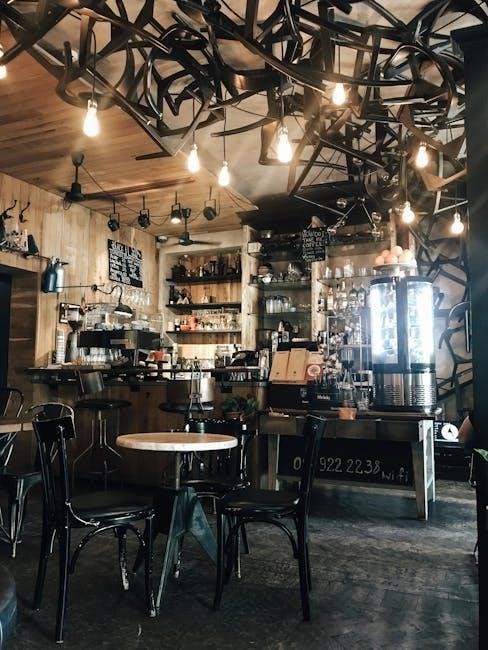
Streamline your restaurant’s launch with a comprehensive checklist․ Ensure efficiency, food safety, and exceptional customer experiences․ Our free PDF guide covers essential steps for a seamless and successful opening․
Pre-Opening Preparations
Before your restaurant opens its doors, several critical steps must be completed to ensure a smooth launch․ Finalize your restaurant concept, theme, and menu offerings to create a clear identity․ Secure all necessary permits and licenses, such as food safety certifications and business registrations․ Conduct a health and safety inspection to comply with local regulations․ Hire and train staff, including managers, chefs, and front-of-house teams, to ensure everyone is prepared for opening day․ Complete the dining area setup, including seating arrangements, clean linens, and mise-en-place․ Gather all essential paperwork, such as employee handbooks and supplier contracts․ Register your business with local authorities and notify HMRC if required․ Finally, test all equipment, systems, and workflows to identify and resolve any issues before the grand opening․

Front-of-House Setup
Ensure the dining area is spotless and well-organized․ Tables should be clean, menus accessible, and condiments prepared․ Restrooms must be clean, and payment systems ready․ Train staff on service standards and safety protocols for a smooth start․
Dining Area Readiness
A well-prepared dining area is crucial for a positive customer experience․ Ensure tables are clean, arranged properly, and set with linens, cutlery, and glassware․ Menus should be accessible, clean, and free of damage․ Check that condiments, napkins, and water glasses are placed correctly․ Verify seating arrangements meet capacity and comfort standards․ Lighting and music should create an inviting ambiance․ Restrooms must be clean, well-stocked, and odor-free․ Ensure all payment systems and POS terminals are functional․ Conduct a final walk-through to address any issues before opening․ Train staff to maintain these standards throughout service․ A polished dining area reflects professionalism and sets the tone for a memorable dining experience for your guests․
Front-of-House Daily Tasks
Front-of-house daily tasks are essential for ensuring smooth operations and exceptional customer service․ Begin by cleaning and sanitizing all areas, including tables, chairs, and restrooms․ Restock supplies like napkins, condiments, and menus․ Ensure all payment systems and POS terminals are functioning properly․ Train staff to greet guests warmly, manage reservations, and seat customers efficiently․ Assign roles for hosts, servers, and bartenders, and conduct a pre-shift briefing to review specials and procedures․ Maintain cleanliness throughout service, clear tables promptly, and handle payments accurately․ Monitor customer satisfaction and address any issues promptly․ End the day by reconciling sales, restocking items, and preparing for the next shift․ These tasks ensure a seamless dining experience and reflect the restaurant’s commitment to quality and hospitality․

Back-of-House Operations
Efficient kitchen operations are vital for a restaurant’s success․ Manage inventory, order supplies, and ensure food safety protocols․ Train staff on equipment, hygiene, and workflow to maintain high standards and consistency․
Kitchen Preparation
A well-prepared kitchen is essential for smooth restaurant operations․ Start by cleaning and sanitizing all equipment, utensils, and surfaces․ Ensure mise-en-place is completed, with ingredients prepped and organized․ Check that all appliances are functioning properly and safety protocols are in place․ Review inventory levels and restock supplies as needed․ Train kitchen staff on their specific roles, from food preparation to plating․ Develop a clear workflow to maintain efficiency during service․ Ensure all food safety regulations are met, including proper storage and temperature controls․ Assign tasks for daily cleaning and maintenance to uphold hygiene standards․ Conduct a final walk-through before opening to confirm everything is ready for service․ A thorough kitchen preparation ensures consistency, quality, and safety in every dish served․
Back-of-House Daily Tasks
The back-of-house (BOH) is the heart of your restaurant, requiring meticulous daily tasks to ensure smooth operations․ Begin with ingredient preparation, including chopping, marinating, and portioning․ Conduct a thorough inventory check to restock supplies and avoid shortages․ Clean and sanitize all equipment, utensils, and workstations regularly to maintain hygiene standards․ Assign specific roles to each kitchen staff member, such as line cooks, dishwashers, and expediters, to streamline workflow․ Monitor food storage temperatures and rotate stock to prevent waste․ Implement a waste management system for recycling and disposal․ Schedule routine maintenance for kitchen equipment to prevent breakdowns․ Finally, end each day with a deep clean of the kitchen, including ovens, floors, and storage areas․ These daily tasks ensure efficiency, safety, and consistency in delivering high-quality dishes to your customers․

Licensing and Permits
Obtain necessary licenses and permits for legal operation․ Ensure food safety, health, and fire certifications․ Secure liquor and business licenses․ Verify local regulations compliance, including food service, sales tax, and employer ID number․
Essential Licenses for Restaurants
Securing the right licenses is crucial for legal restaurant operation․ Key requirements include a food service permit, ensuring food safety compliance, and a business license to operate legally․ Restaurants must also obtain a health department permit, confirming adherence to hygiene standards․ Additionally, a fire department clearance is necessary to ensure safety measures are in place․ If serving alcohol, a liquor license is mandatory․ Restaurants may also need an employer ID number for tax purposes and a sales tax permit to collect and remit sales tax․ Requirements vary by location, so it’s essential to consult local authorities to ensure compliance․ Failure to obtain necessary licenses can result in fines or operational shutdowns․ Staying informed and proactive in securing these permits is vital for a smooth and lawful restaurant launch․

Staff Training and Management
Effective staff training ensures smooth operations․ Conduct pre-shift meetings, provide role-specific orientations, and train on safety protocols․ Foster a culture of accountability and continuous improvement for long-term success․
Pre-Shift Meetings and Orientation
Pre-shift meetings are crucial for aligning your team and ensuring a smooth service․ Begin with a briefing on daily specials, menu updates, and key tasks․ Review safety protocols, cleanliness standards, and customer service expectations․ Use this time to address any staff concerns or questions․ Orientation should be comprehensive, covering role-specific responsibilities, restaurant policies, and emergency procedures․ Provide detailed training on equipment, POS systems, and hygiene practices․ Ensure all staff understand their roles in maintaining food safety and delivering exceptional customer experiences․ Regular pre-shift meetings and thorough orientation set the foundation for a well-prepared and confident team, reducing errors and enhancing overall efficiency․ Make these sessions interactive and engaging to foster a positive work environment․ Consistency in these practices guarantees a professional and cohesive operation from day one․
Financial Planning and Supplies
Thorough financial planning and supply management are vital for a successful restaurant launch․ Start by creating a detailed budget that covers startup costs, operational expenses, and contingency funds․ Secure funding through loans, investors, or personal savings, and ensure all financial documents are organized․ Source high-quality suppliers for food, beverages, and equipment, negotiating favorable terms․ Implement an inventory management system to track stock levels and reduce waste․ Plan for uniform procurement, POS systems, and essential kitchen tools․ Regularly review financial statements to monitor profitability and identify cost-saving opportunities․ Consider pre-opening expenses, such as staff training and marketing, to avoid unexpected shortages․ A well-structured financial plan and efficient supply chain ensure sustainability and growth․ Prioritize transparency in accounting practices to maintain legal compliance and build trust with stakeholders․ With careful planning, your restaurant can achieve financial stability from day one․